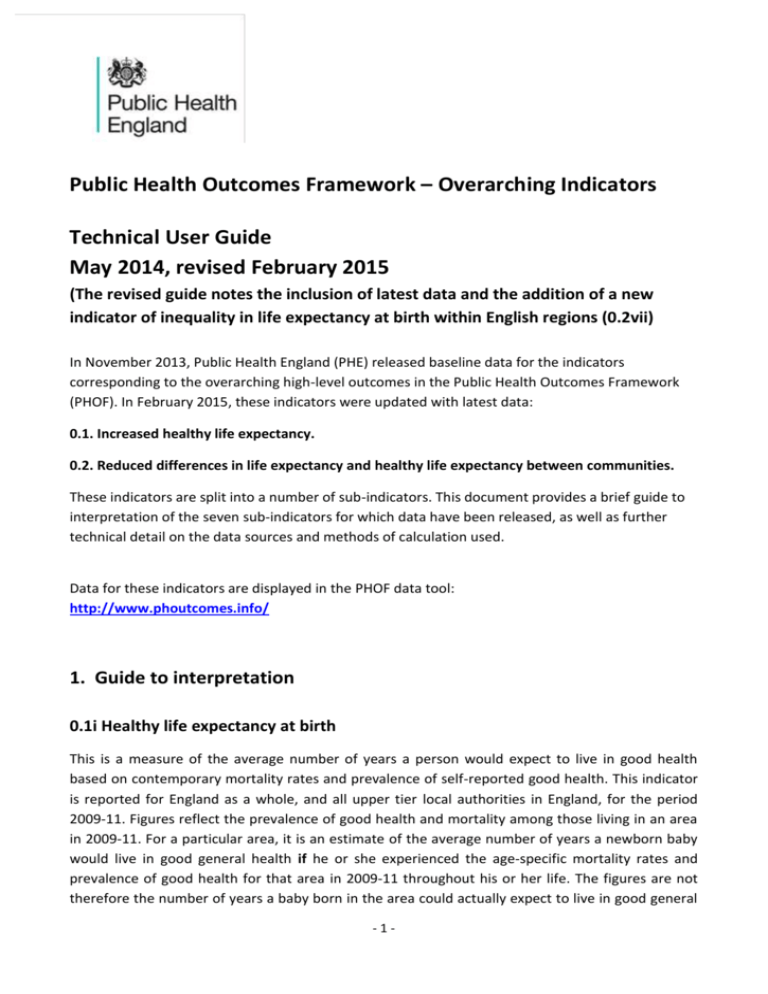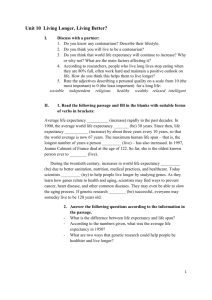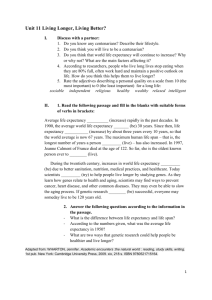Technical user guide - PHOF overarching indicators
advertisement

Public Health Outcomes Framework – Overarching Indicators Technical User Guide May 2014, revised February 2015 (The revised guide notes the inclusion of latest data and the addition of a new indicator of inequality in life expectancy at birth within English regions (0.2vii) In November 2013, Public Health England (PHE) released baseline data for the indicators corresponding to the overarching high-level outcomes in the Public Health Outcomes Framework (PHOF). In February 2015, these indicators were updated with latest data: 0.1. Increased healthy life expectancy. 0.2. Reduced differences in life expectancy and healthy life expectancy between communities. These indicators are split into a number of sub-indicators. This document provides a brief guide to interpretation of the seven sub-indicators for which data have been released, as well as further technical detail on the data sources and methods of calculation used. Data for these indicators are displayed in the PHOF data tool: http://www.phoutcomes.info/ 1. Guide to interpretation 0.1i Healthy life expectancy at birth This is a measure of the average number of years a person would expect to live in good health based on contemporary mortality rates and prevalence of self-reported good health. This indicator is reported for England as a whole, and all upper tier local authorities in England, for the period 2009-11. Figures reflect the prevalence of good health and mortality among those living in an area in 2009-11. For a particular area, it is an estimate of the average number of years a newborn baby would live in good general health if he or she experienced the age-specific mortality rates and prevalence of good health for that area in 2009-11 throughout his or her life. The figures are not therefore the number of years a baby born in the area could actually expect to live in good general -1- health. This is because the health prevalence and mortality rates of the area are likely to change in the future and because many of those born in the area will live elsewhere for at least some part of their lives. The prevalence of good health is derived from responses to a question on general health in the Annual Population Survey (APS) conducted by the Office for National Statistics (ONS). Respondents were asked to assess their own general health, in response to the question “How is your health in general; would you say it was…Very good / Good / Fair / Bad or Very bad?” The responses “Very good” and “Good” are categorised as ‘Good’ general health and “Fair”, “Bad” or “Very bad” as ‘Not Good’ general health. Healthy life expectancy is a measure of a population’s general health, it does not provide an indicator of functional health status, such as whether daily activities are restricted because of health problems. The figures are based on people living in private households; they exclude residents of communal establishments except NHS housing and students in halls of residence where inclusion takes place at their parents' address. A brief summary of the methods of calculation and data sources for the healthy life expectancy indicator can be found in Section 3 of this document. ONS have also issued a statistical bulletin for this indicator. This includes more detail on the method of calculation and analyses of the results. ONS have also published figures for English regions to accompany results for upper tier local authorities: http://www.ons.gov.uk/ons/rel/disability-and-health-measurement/healthy-life-expectancy-atbirth-for-upper-tier-local-authorities--england/2009-11/index.html 0.1ii Life expectancy at birth This is the average number of years a person would expect to live based on contemporary mortality rates. This indicator is reported for England as a whole, and all upper and lower tier local authorities in England, for the periods 2000-02 to 2011-13. Figures reflect mortality among those living in an area in each time period. For a particular area, it is an estimate of the average number of years a newborn baby would live if he or she experienced the age-specific mortality rates for that area for the time period throughout his or her life. The figures are not therefore the number of years a baby born in the area could actually expect to live. This is because the mortality rates of the area are likely to change in the future and because many of those born in the area will live elsewhere for at least some part of their lives. This indicator provides context to the indicator of healthy life expectancy (0.1i), which estimates how many years of the estimated length of life will be lived in good general health. A brief summary of the methods of calculation and data sources for the life expectancy indicator can be found in the technical guide in Section 3 of this document. ONS have published life -2- expectancy at birth data for each time period alongside figures for life expectancy at age 65. These include figures for English regions as well as data for local authorities: http://www.ons.gov.uk/ons/rel/subnational-health4/life-expectancy-at-birth-and-at-age-65-bylocal-areas-in-england-and-wales/2011-13/index.html 0.2i Slope index of inequality in life expectancy at birth based on national deprivation deciles of Lower Super Output Areas within England 0.2iii SIope index of inequality in life expectancy at birth within each English upper and lower tier local authority, based on local deprivation deciles of Lower Super Output Areas 0.2vii SIope index of inequality in life expectancy at birth within each English region , based on regional deprivation deciles of Lower Super Output Areas These three indicators provide information on inequalities in life expectancy at birth between communities. The Slope Index of Inequality (SII) is a measure of the social gradient in life expectancy, i.e. how much life expectancy varies with deprivation. It takes account of health inequalities across the whole range of deprivation within an area and summarises this in a single number. This represents the range in years of life expectancy across the social gradient from most to least deprived. The chart in Figure 1 illustrates how the SII is calculated. Within each upper and lower tier local authority, the population has been divided by level of deprivation. This has been done by ranking Lower Super Output Areas (LSOAs) from most to least deprived. These have then been divided into 10 groups, or deprivation deciles, with approximately equal numbers of LSOAs in each. Decile 1 contains people living in the most deprived parts of the local authority and Decile 10 contains people in the least deprived parts. Life expectancy at birth has been calculated for each of these deciles, illustrated by the blue dots in Figure 1. (Life expectancy at birth is defined in Indicator 0.1ii and notes on the definitions of LSOAs and deprivation can be found in the following Section 2). In Figure 1, the life expectancy figures have been plotted to take account of their population size (see Section 3 for details). The red line on the chart is a linear regression line of best fit for the data, calculated by the least squares method. The SII is simply the gradient of that line, or the difference between the top of the line (at 100% on the horizontal axis) and the bottom (0% on the horizontal axis). In the example in Figure 1, the regression line goes from 78.0 to 85.9 years. This -3- gives an SII of 7.9 years (with a 95% confidence interval of 6.7 to 9.1 years). The range in life expectancy across the social gradient from most to least deprived in this local authority is therefore 7.9 years. Figure 1 – Life expectancy by deprivation decile and the slope index of inequality Slope index of inequality = 7.9 years (95% Confidence Interval: 6.7 to 9.1) 95 Life Expectancy at Birth (years) 90 85 Life expectancy at birth 80 75 70 65 60 0% 20% 40% 60% 80% 100% Percentage of population, ranked from most to least deprived The SII results for for England and English regions are calculated in the same way, but with LSOAs ranked from most to least deprived within England as a whole, to form national deprivation deciles, and within regions as a whole to form regional deprivation deciles. The SII gives a description of the extent of inequality in each local authority, and is broadly comparable between areas. Some areas have more diverse populations than others, in terms of deprivation. Because life expectancy and deprivation are so strongly correlated, local authorities with a wider range of deprivation will tend to have greater ranges of life expectancy and therefore a larger SII. -4- While the SII is broadly comparable between areas, the deprivation deciles are defined separately for each local authority based on the local range of deprivation in the area. The most deprived 10% of the population in a local authority with a high level of deprivation might not therefore be comparable with the most deprived 10% of the population in a more affluent local authority. When interpreting the slope index figures it is therefore important to consider them in the context of the local authority’s overall life expectancy at birth (Indicator 0.1ii) or the gap between life expectancy in the local area and the value for England (0.2iv). The 10% most deprived population within a local authority may also not correspond to the 10% most deprived population identified in the national deprivation deciles within England. Some local authorities do not contain the full range of national deprivation deciles, and will not therefore have any of their population resident in LSOAs which are classified as amongst the least or most deprived deciles in England. An SII figure is provided for England to indicate the extent of inequalities in life expectancy across the whole country, which can be measured over time. The SII for England should not be considered as a comparator for the local authority figures, however. The SII for England takes account of the full range of deprivation and mortality across the whole country. This does not therefore provide a suitable benchmark with which to compare local authority results, which take into account the range of deprivation and mortality within much smaller geographies. For this reason, the SII results for local authorities in the PHOF tool are not colour coded to show whether they are statistically higher or lower than the England value and the England figures are presented separately from the figures for local authorities. Similarly, an SII figure is provided for each of the English regions to indicate the extent of inequalities in life expectancy within the region. As with the England figure, these should not be considered as a comparator or benchmark for the local authority figures, and are therefore presented separately from the figures for local authorities. Figures for the life expectancy SII indicators have been released for England as a whole and for all English regions and upper and lower tier local authorities for 2011-13, along with historical trend data for 2002-04 onwards. These data use rebased population estimates for the relevant years derived from the 2011 Census. -5- Life expectancy at birth for deprivation deciles Figure 1 illustrates how the SII indicators are based on estimates of life expectancy for deprivation deciles. Life expectancy at birth has therefore been calculated for each deprivation decile within each local authority, region, and England as a whole. These figures can be accessed from the Further Information tab within the PHOF tool: http://www.phoutcomes.info/further-information 0.2ii Number of upper tier local authorities for which the local SII in life expectancy (as defined in 0.2.iii) has decreased This is a summary measure of the number of local authorities for which local within-area inequalities in life expectancy (as measured by Indicator 0.2iii) have decreased. It shows a count of the number of upper tier local authorities where the SII measure has decreased since the baseline time period, and is currently available for 2010-12 and 2011-13, showing the number where SII has decreased since 2009-11. 0.2iv Gap in life expectancy at birth between each local authority and England as a whole This indicator provides context for the indicator of inequality in life expectancy within each English local authority (0.2iii) by giving the difference between life expectancy at birth in a whole local authority area and the England value for life expectancy at birth. This provides an indication of overall life expectancy in the local authority relative to the level for England. Figures are provided for upper and lower tier local authorities from 2000-02 to 2011-13. 0.2v Slope Index of Inequality in healthy life expectancy at birth based on national deprivation deciles of LSOAs within England This indicator has been calculated using the same definition of healthy life expectancy described for indicator 0.1i. The slope index of inequality has been calculated using the method described above for the SII in life expectancy (0.2i). Healthy life expectancy at birth for deprivation deciles -6- For healthy life expectancy, figures for deprivation deciles at England level were released by ONS in March 2014: http://www.ons.gov.uk/ons/rel/disability-and-health-measurement/inequality-in-healthy-lifeexpectancy-at-birth-by-national-deciles-of-area-deprivation--england/2009-11/index.html Indicators not yet published Data have not yet been released for one of the overarching sub-indicators in the PHOF: 0.2vi Local measure of healthy life expectancy at birth Currently no recent data are available to monitor this. However, PHE has commissioned ONS to produce small area healthy life expectancy figures which will provide a local measure of inequality, These figures will be based on data from the 2011 Census and so will be produced for one time point only. The data are expected to available later in 2015. -7- 2. Technical notes Geographies Data for healthy life expectancy (0.1i) have been released for upper tier local authorities. These are English counties, unitary authorities, London boroughs and metropolitan county districts. Figures have not been calculated for the City of London and the Isles of Scilly because of the small populations in these areas. Figures for overall life expectancy (0.1ii), the SII in life expectancy (0.2iii) , and the life expectancy gap with England (0.2iv) are provided for both upper and lower tier local authorities, the latter being county districts within English counties. Figures for regions use the boundaries of the former English Government Office Regions. The four SII indicators (0.2i, 0.2iii, 0.2v and 0.2vii) are based on LSOAs - small areas of relatively even size (around 1,500 people) of which there are now 32,844 in England . ONS mid-year population estimates for 2002-13, are based on 2011 LSOA boundaries. Deprivation scores from the Index of Multiple Deprivation 2010 (IMD 2010) are however published on 2001 LSOA boundaries. Where necessary, PHE adjusted the IMD scores to align them with 2011 LSOA boundaries. The adjusted scores are available here: http://www.apho.org.uk/resource/view.aspx?RID=125886 This file also contains the assignment of LSOAs to deprivation deciles within local authorities, regions and England as a whole. Time trends Data for the indicators of healthy life expectancy (0.1i), and the SII in healthy life expectancy (0.2v) form the start of a new data series. ONS have been publishing data on life expectancy at birth for local authorities for many years, and these data for life expectancy at birth from 2000-02 onwards are now included in the PHOF data tool. Time trends in the SII in life expectancy at birth for local authorities from 2002-04 to 2011-13 have now been published within the PHOF tool. The PHOF data are not comparable to SII time trend data previously published by PHE showing local authority data from 2001-05 to 2006-10. The PHOF latest figures are based on three-years of data and are calculated with populations based on the 2011 Census. Earlier results were based on five-years of data and calculated with populations based on -8- the 2001 Census. For upper tier local authorities, PHE has changed the basis for reporting the SII in life expectancy from five years to three years of data, after analysis which indicated that the latter still provided robust indicators at this level of geography. Using three years of data should help keep these indicators up-to-date and more responsive to short term changes. Deprivation For the SII indicators, deprivation has been defined using the Index of Multiple Deprivation 2010. This is generally accepted as the current standard measure of deprivation, it is widely used and familiar to a large audience. IMD 2010 is constructed from 38 indicators grouped into 7 domains: Income, Employment, Health and Disability, Education Skills and Training, Barriers to Housing and Services, Living Environment, and Crime. IMD 2010 was used to define deprivation for the baseline SII figures for 2009-11 and has also been used to define deprivation for all other time periods. The trend figures back to 2002-04 therefore illustrate past inequalities between areas defined by their level of deprivation in the baseline period. The use of IMD 2010 for all time periods provides a comparable time series of SII results. An alternative approach, such as using IMD indices closest to the time period that the data relate to, was not adopted for these trend data. Definitional differences between the different versions of the IMD would introduce uncertainty as to whether changes in the SII over time were reflecting differences in the measure of deprivation, or reflecting changes in the relative health status of communities over time. Confidence Intervals Each of the seven indicators has been released with 95% confidence intervals. These provide a range of values which describe uncertainty around the calculated values. This uncertainty arises from factors which influence the indicators which may be subject to chance, such as random fluctuation in the numbers of deaths occurring in an area. The healthy life expectancy indicators are also based on data from the Annual Population Survey, which questions only a sample of the population. Uncertainty can therefore also arise from random differences between that sample and the population itself. A 95% confidence interval implies that 95 times out of 100, the interval will include the true underlying value. For the SII indicators, the uncertainty reflects how well the slope line (the red line in Figure 1) fits the decile life expectancy figures. There will always be variation in the life expectancy figures resulting from random fluctuation in numbers of deaths, but there is also variation in the degree to which the linear relationship between deprivation deciles and life expectancy is appropriate. The -9- width of the confidence interval depends on the closeness of the decile life expectancy figures to the slope line. In the PHOF tool, the 95% confidence intervals have been used to indicate whether values for local authorities are statistically significantly higher, lower or similar to the value for England. This has not been indicated for the SII in life expectancy however for local authorities and regions (0.2iii and 0.2vii) for the reasons detailed in Section 1 on the interpretation of these indicators. Populations Following the 2011 Census, ONS has revised its time series of mid-year population estimates. ONS carries out this process of revision after every census, as the census provides the most complete information about the population. All of the PHOF overarching indicators using population data from 2002 onwards have now been calculated with rebased population estimates for the relevant time periods, and are final figures. 3. Calculation of indicators 0.1i Healthy life expectancy at birth Healthy life expectancy has been calculated by ONS using abridged Sullivan life tables, for males and females separately using 5 year age bands. A Sullivan life table extends the traditional life table by partitioning years lived into favourable and unfavourable health states to provide an estimate of healthy life expectancy for males and females at birth and each geographical unit. In addition to the number of deaths and mid-year population estimates used in a traditional life table, the Sullivan life table also incorporates the proportion of people reporting their general health as good or very good from a data source, in this case from the Annual Population Survey. In response to the question “How is your health in general; would you say it was…”, responses “Very good” and “Good” are categorised as ‘Good’ health and “Fair”, “Bad” or “Very bad” as ‘Not Good’ health. The 95% confidence intervals calculated around the healthy life expectancy estimates for each area follow the methodology outlined in "Health Expectancy Calculations by the Sullivan Method: A Practical Guide".1 This methodology assumes that if the sample size of the survey producing the prevalence rates is not very large compared with the population on which the mortality data are based, then the variance from the mortality rates is negligible. Therefore only the variance of the health prevalence rates is used when calculating the confidence intervals for healthy life expectancy in this output. The Annual Population Survey used for estimating the health prevalence has a complex design; this is taken account of in the confidence interval calculation. Further detail on this indicator can be found in the statistical bulletin on the ONS website: http://www.ons.gov.uk/ons/rel/disability-and-health-measurement/healthy-life-expectancy-at- 10 - birth-for-upper-tier-local-authorities--england/2009-11/stb-hle--at-birth-for-upper-tier-localauthorities--england-2009-11.html 0.1ii Life expectancy at birth This indicator was calculated by ONS using abridged life tables (based on five-year age groups) constructed using standard methods.2,3 Separate tables were constructed for males and females using numbers of deaths registered in calendar years and annual mid-year population estimates. A life table template which illustrates the method used to calculate life expectancy (and 95% confidence intervals) can be found on the ONS website: http://www.ons.gov.uk/ons/rel/subnational-health4/life-expec-at-birth-age-65/2004-06-to-200810/ref-life-table-template.xls The 95% confidence interval (CI) for each area was calculated using the revised Chiang method (Chiang II), allowing the calculation of the variance of the mortality rates for those age groups with no deaths registered in the analysis period. This method is the approved standard for ONS outputs of life expectancy at sub-national level.4 0.2i Slope index of inequality in life expectancy at birth based on national deprivation deciles of Lower Super Output Areas within England 0.2iii SIope index of inequality in life expectancy at birth within each English upper tier local authority, based on local deprivation deciles of Lower Super Output Areas 0.2vii SIope index of inequality in life expectancy at birth within each English region, based on regional deprivation deciles of Lower Super Output Areas These indicators were calculated by PHE using mortality data from ONS and ONS mid-year population estimates for LSOAs for the relevant time periods. LSOAs within England were ranked from most to least deprived and then divided into national deprivation deciles with approximately equal numbers of LSOAs within each of the ten categories. Within each region and local authority, this process was repeated to assign LSOAs to regional and local deprivation deciles within each area. The method for doing this, and the assignment of LSOAs to deprivation categories, is available here: http://www.apho.org.uk/resource/view.aspx?RID=125886 Deaths were assigned to 2011 LSOA boundaries using the November 2013 National Statistics Postcode Lookup file for time periods 2002-04 to 2010-12. The November 2014 National Statistics Postcode Lookup file was used for 2011-13. The mortality data and population estimates were - 11 - aggregated into deprivation deciles for each local authority, region, and for England as a whole, and life expectancy results were then calculated using the calculator developed by the former South East Public Health Observatory: http://www.sepho.org.uk/viewResource.aspx?id=8943 The calculation of the confidence intervals within this was made using the method developed by Chiang.5 The calculator however also includes an adjustment to include a term for the variance associated with the final age interval as developed by Silcocks.6 This method differs slightly from the one used by ONS for calculating confidence intervals for its life expectancy at birth figures for local authorities. As illustrated in Figure 1, the SII is calculated using population‐weighted linear regression and it represents the hypothetical absolute difference in life expectancy between the extremes of deprivation within a local authority or within England as a whole. While the deprivation deciles have roughly one‐tenth of the population in each, they are not precisely equal because they are aggregated up from LSOAs. The horizontal x‐axis along the bottom of the chart in Figure 1 represents the whole population of an area (a local authority or England as a whole). Each blue dot in Figure 1 represents the life expectancy at birth for each deprivation decile. If Decile 1 includes exactly 10% of the population, the first blue dot is positioned at 5%, the mid‐ point of the range of population covered by that decile. If the second decile includes 11% of the population, this would cover the range from 10% to 21%, so the midpoint is 15.5%, and that is where the point would be located on the x‐axis. The 0% and 100% points on the x‐axis nominally represent the most and least deprived individuals in the area. The red line on the chart is a linear regression line of best fit for the data, calculated by the least squares method. The SII is the gradient of the resulting fitted line, i.e. m in the equation y = mx + c. Confidence intervals are calculated around the gradient of the line using the method detailed by Low and Low,7 and the confidence intervals for the gradient of a regression line defined by Altman.8 The SII, along with other methods of measuring inequalities, are explained in a ScotPHO guide.9 In some local authorities a meaningful life expectancy estimate cannot be calculated for every local deprivation decile because of the population of the deprivation decile is lower than 5,000, or because there is large uncertainty in the life expectancy value (where confidence intervals are wider than 20 years). In these cases, the SII in life expectancy has not been provided in the data tool. 0.2iv Gap in life expectancy at birth between each local authority and England as a whole - 12 - This indicator was calculated by PHE using life expectancy at birth figures published by ONS. The life expectancy at birth figure for each local authority was subtracted from the figure for England to give the absolute gap, in years, for each area. For this indicator, confidence intervals around the life expectancy at birth values for each local authority have been applied to the gap with England figures. The lower and upper confidence limit for each area has been subtracted from the England life expectancy value. (The confidence interval around England itself has been ignored as it is very narrow.) For each local authority, the statistical significance compared with England of its overall life expectancy (0.1ii) and gap with England (0.2iv) is therefore identical. 0.2v Slope Index of Inequality in healthy life expectancy at birth based on national deprivation deciles of LSOAs within England This indicator was calculated by ONS based on healthy life expectancy for deprivation deciles. ONS used the May 2013 postcode directory to assign deaths to LSOAs and subsequently to deprivation deciles, meaning that there are some small differences in life expectancy by decile reported by ONS compared to the PHOF data tool. These data were used to calculate SII in the same was as described for indicators 0.2i and 0.2iii above. Enquiries and comments on the PHOF indicators can be e-mailed to phof.enquiries@phe.gov.uk - 13 - References 1. Jagger C, Cox, B, Le Roy S, European Health Expectancy Monitoring Unit. Health Expectancy Calculation by the Sullivan Method. Third Edition. EHEMU Technical Report September 2006: http://maryland.mri.cnrs.fr/ehleis/pdf/Sullivan_guide_final_jun2007.pdf 2. Shyrock HS and Siegel JS (1976) The Methods and Materials of Demography (abridged edition), Academic Press: New York. 3. Newell C (1994) Methods and Models in Demography, John Wiley & Sons: Chichester. 4. Toson B and Baker A (2003) Life expectancy at birth: methodological options for small populations. National Statistics Methodological Series No.33: http://www.ons.gov.uk/ons/guide-method/method-quality/specific/gss-methodologyseries/index.html 5. Chiang CL. The Life Table and its Construction. In: Introduction to Stochastic Processes in Biostatistics. New York, John Wiley & Sons, 1968:189‐214. 6. Silcocks PBS, Jenner DA, Reza R. Life expectancy as a summary of mortality in a population: statistical considerations and suitability for use by health authorities. J Epidemiol Community Health 2001;55:38‐43. 7. Low A, Low A. Measuring the gap: quantifying and comparing local health inequalities. J Public Health 2004;26(4):388‐395. 8. Altman D. Practical Statistics for Medical Research, London, Chapman & Hall/CRC, 1991. 9. Muñoz‐Arroyo R, Sutton M. Measuring Socio‐Economic Inequalities in Health: A Practical Guide. Edinburgh, ScotPHO, 2007. - 14 -







